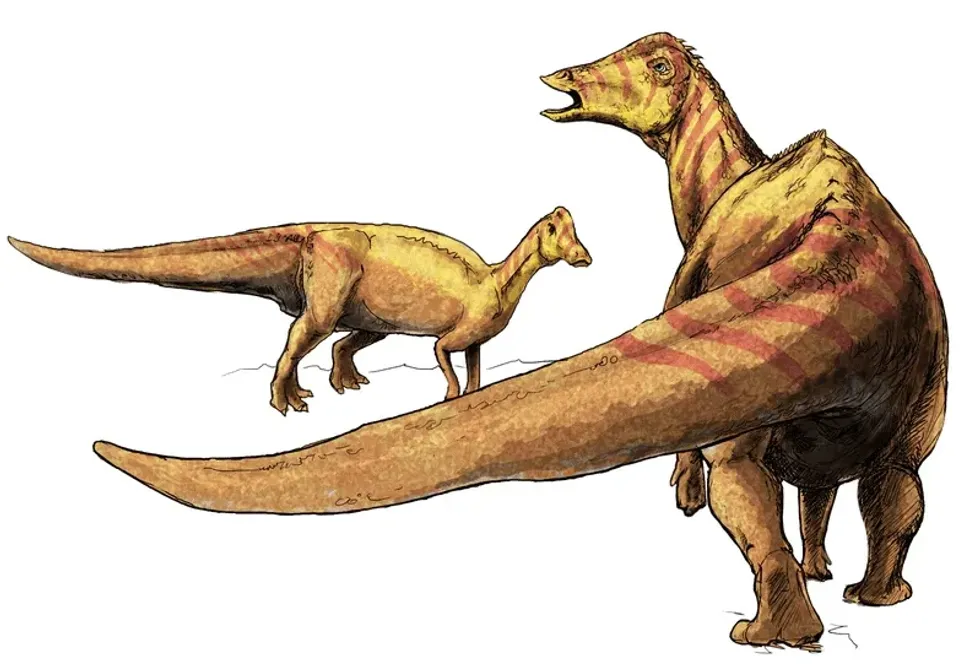Barsboldia is a genus that comprises large-sized hadrosaurid dinosaurs that existed during the Maastrichtian Age of the Early Cretaceous period. It comprises three species, namely, Barsboldia sicinskii, Barsboldia gibbosi, and Barsboldia dorsum.
These dinosaurs were found in Ömnogöv', Mongolia's early Maastrichtian Nemegt Formation. This genus was named in 1981 after a renowned Mongolian paleontologist, Rinchen Barsbold, and means 'of Barsbold'.
It was named in 1981 by H. Osmólska and T. Maryanska. It belongs to the clade Dinosauria, order Ornithischia, family Hadrosauridae, and subfamily Saurolophinae. It is closely related to Edmontosaurus and Shantungasaurus.
This genus is known from fossil remains of some ribs, partial pelvis, and partial vertebral column. The bones are also known to resemble the bones of Hypacrosaurus closely. The original describers classified it as a lambeosaurine hadrosaurid dinosaur.
However, later studies doubted the classification of Barsboldia as a lambeosaurine, especially in 2011 by Albert Prieto-Márquez. The adult of this species is estimated to have a length of 36 ft (10.9 m), was 13 ft (3.9 m) tall, and weighed 5.5 tons (4989.5 kg).
The size of Barsboldia is estimated to be double the size of Lambeosaurus. Keep reading to learn more Barsboldia facts about its history, fossil remains, physical features, related dinosaurs, and more!
If you enjoyed reading our Barsboldia fun facts, you must discover our roar-some facts about the Tanycolagreus and Luanchuanraptor facts for kids!
Barsboldia Interesting Facts
How do you pronounce 'Barsboldia'?
Barsboldia can be pronounced as 'Barz-bol-de-uh'.
What type of dinosaur was a Barsboldia?
Barsboldia is a genus that comprises three species of Lambeosaurine hadrosaurs from late Cretaceous Mongolia, namely, Barsboldia sicinskii, Barsboldia gibbosi, and Barsboldia dorsum. They belong to the clade Dinosauria, order Ornithischia, family Hadrosauridae, and subfamily Saurolophinae. This genus was named in 1981 in the honor of the Mongolian paleontologist Rinchen Barsbold.
Barsboldia is known only from some fragments of its postcranial skeleton and vertebrae.
When the genus was described initially, there was no skull known, but it still ended up being described as a lambeosaurine hadrosaurid dinosaur. Later studies doubted the classification of Barsboldia as a lambeosaurine, especially in 2011 by Albert Prieto-Márquez.
It was further concluded that the Barsboldia is a saurolophine hadrosaur. This was backed by the proof that by the Maastrichtian period, saurolophine hadrosaurs had largely replaced lambeosaurine hadrosaurs.
This also implied that Barsboldia possessed a solid small bone crest. Although, studies from the early 21st century of the Edmontosaurus genus proved that soft tissue crests were possessed by some saurolophine hadrosaurs.
In which geological period did the Barsboldia roam the earth?
It is an extinct genus of hadrosaur dinosaurs that existed in Mongolia from 83.6 million years ago through the Maastrichtian Age of the Early Cretaceous period.
When did the Barsboldia become extinct?
These dinosaur species from the late cretaceous of Mongolia are believed to have gone extinct after the Eary Cretaceous period.
Where did a Barsboldia live?
This Lambeosaurine hadrosaur from late Cretaceous Mongolia is believed to have dwelled in and near Mongolia as fossil remains of this dinosaur were collected from the Nemegt Formation in Mongolia.
What was a Barsboldia's habitat?
These dinosaurs were terrestrial and dwelled in a habitat that had plenty of plants and water.
Who did a Barsboldia live with?
This dinosaur came from the Nemegt Formation and is assumed to have dwelled with hadrosaurids like ankylosaurs such as Tarchia, Saurolophus, and titanosaurs such as Nemegtosaurus during the Maastrichtian Age of the Cretaceous period. The Barsboldia is quite large in size and is also related to Edmontosaurus and Shantungasaurus closely.
How long did a Barsboldia live?
The lifespan of Barsboldia is not yet available. However, hadrosaurids are believed to have had an estimated lifespan of 25 years.
How did they reproduce?
This dinosaur reproduced by laying eggs. The details of its reproduction are not available due to a lack of research.
Barsboldia Fun Facts
What did a Barsboldia look like?
 *We've been unable to source an image of Barsboldia and have used an image of Hypacrosaurus instead. If you are able to provide us with a royalty-free image of Barsboldia, we would be happy to credit you. Please contact us at hello@kidadl.com
*We've been unable to source an image of Barsboldia and have used an image of Hypacrosaurus instead. If you are able to provide us with a royalty-free image of Barsboldia, we would be happy to credit you. Please contact us at hello@kidadl.com All we have learned about Barsboldia is known from fossil remains of ribs, partial pelvis, and a partial vertebral column comprising nine dorsal vertebrae, nine hip vertebrae, right pubis, and hind limbs.
The bones are also known to closely resemble the bones of Hypacrosaurus. The adult of this species is estimated to have had a length of 36 ft (10.9 m), 13 ft (3.9 m) in height, and weighed 5.5 tons (4989.5 kg).
It possessed skin hanging below its neck which is quite similar to a Zebu's dewlaps.
One of the interesting features of this dinosaur is that it also had a big nose that is assumed to have vibrated when this dinosaur created a call, producing a bellowing deep roar. Studies done in the early 21st century of the Edmontosaurus genus proved that soft tissue crests were possessed by some saurolophine hadrosaurs.
The size of Barsboldia is estimated to be double the size of Lambeosaurus.
How many bones did a Barsboldia have?
The precise number of bones is not available. However, we do know that its bones closely resemble the bones of Hypacrosaurus.
How did they communicate?
This dinosaur had physical features that suggest it could communicate vocally. It also had a big nose that is believed to have vibrated when it produced calls, creating a bellowing sound.
How big was a Barsboldia?
The adult Barsboldia is estimated to have had a length of 36 ft (10.9 m) and a height of 13 ft (3.9 m). Its length is estimated to be double that of Lambeosaurus.
How fast could a Barsboldia move?
The precise speed of these large dinosaurs has not yet been evaluated. However, it is assumed to have been bipedal or quadrupedal. It is also believed that hadrosaurs of Haudrosauridae could attain a speed of 40 mph (64.3 kph).
How much did a Barsboldia weigh?
It is estimated that these dinosaurs could weigh approximately 5.5 tons (4989.5 kg) which is as much as that of two or three present-day rhinoceroses.
What were the male and female names of the species?
The suffix of the term dinosaur is saurus for males and saura for females.
What would you call a baby Barsboldia?
The baby of the Barsboldia can be referred to as a hatchling or juvenile.
What did they eat?
It was a herbivore and fed upon plant material. This dinosaur did not live free from threats. It is believed to have been preyed upon by large tyrannosaurs like Tarbosaurus and Alioramus.
How aggressive were they?
These dinosaurs are not believed to have been aggressive as they were herbivores and did not feed upon other animals.
Did you know...
These dinosaurs possessed hundreds of teeth that were continually replaced!
What does Barsboldia mean?
It was named as Barsboldia in 1981 by H. Osmólska and T. Maryanska. It was named in honor of the renowned Mongolian paleontologist Rinchen Barsbold and means 'of Barsbold'.
What is the Barsboldia known for?
Barsboldia is known for its bold features such as its big vibrating nose, large body, and hanging skin under its neck.
Here at Kidadl, we have carefully created lots of interesting family-friendly dinosaur facts for everyone to discover! Learn more about some other creatures from our Preondactylus fun facts and Fabrosaurus surprising facts for kids.
You can even occupy yourself at home by coloring in one of our free printable Barsboldia coloring pages.
*We've been unable to source an image of Barsboldia and have used an image of Nipponosaurus instead as the main image. If you are able to provide us with a royalty-free image of Barsboldia, we would be happy to credit you. Please contact us at hello@kidadl.com







